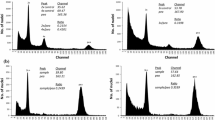Summary
Odd multiple polyploids are relatively infertile, consequently in fruits such asRubus and.Prunus, where seed and fruit development are closely associated, triploid and other odd multiple forms are relatively unproductive. Triploid apples however are productive,e.g. Bramley’s Seedling, a triploid, is probably more widely cultivated in this country than any other apple.
In apples a very low proportion of fruit to flowers is sufficient to give a yield. The apple has ten embryos, and often a single seed is sufficient for the development of a fruit, and even this seed may be imperfect. This approaches parthenocarpy and renders fruit production still less dependent on the formation of seeds. Fruitfulness in apples may therefore be maintained in spite of a high degree of generational sterility.
Triploidy in apples is another example of the occurrence of sterile forms in species where a substitute has been found (either in nature or in cultivation) for normal seed and fruit production. The substitution in apples is more complex than usual for, while sexual reproduction is now replaced by grafting, the necessity for the stimulus of seed growth in the formation of a fruit is largely evaded. Therefore triploids are able to fruit although incapable as a rule of yielding offspring of any value.
The offspring of triploids, whether derived from selling or crossing with diploids, lack vigour, presumably owing to their aneuploid constitution (cf. Darlington and Moffett). Consequently triploid varieties are likely to be of little value in practical breeding as the necessary vigour and fertility would rarely be obtained in the resulting offspring.
Similar content being viewed by others
References
Crane, M. B. (1926). “Studies in relation to sterility in plums, cherries, apples and raspberries.”Mem. Hort. Soc. New York, III.
Crane, M. B. andDarlington, C. D. (1927). “The origin of new forms in Rubus.”Genetica, IX.
Crane, M. B. andLawrence, W. J. C. (1929).“Genetical and cytological aspects of incompatibility and sterility in cultivated fruits.”Journ. Pomol. VII, 4.
Grandall, C. S. (1924). “Additional records of self-sterility in apples.”Proc. Amer. Soc. Hort. Sci. x, 63.
Darlington C. D. andMoffett, A. A. (1930).“Primary and secondary chromosome balance in Pyrus.”Journ. Gen. XXII.
Dickson, G. H. (1928). “Variability of vigour in apple seedlings.”Proc. Amer. Soc. Hort. Sci. XIV, 165.
Florin, R. (1926). “Pollen production and incompatibilities in apples and pears.”Mem. Hort. Soc. New York, III.
Kobel, F. (1927). “Zytologische Untersuchungen an Prunoideen und Pomoideen.”Arch. Jul. Klaus-Stift. III.
Kvaale, E. (1926). “Abortive and sterile apple pollen.”Mem. Hort. Soc. New York, III.
Lantz, H. L. (1925). “Some observations on the effect of inbreeding on the vigor of apple seedlings.”Proc. Amer. Soc. Hort. Sci. XI, 115.
Nebel, B. (1929). “Zur Cytologie von Malus, II.”Zilchter, I, 7.
— (1929). “Zur Cytologie von Malus und Vitis.”Gartenbauwiss. I, 6.
Rybin, V. A. (1926). “Cytological investigations of the genusMalus (preliminary account).”Bull. Appl. Bot. (Lening.), XVI.
Wellington, R. (1924). “An experiment in breeding apples.”Tech. Bull. 160,New York Agr. Exp. Sta. Geneva.
Author information
Authors and Affiliations
Rights and permissions
About this article
Cite this article
Crane, M.B., Lawrence, W.J.C. Fertility and vigour of apples in relation to chromosome number. Journ. of Gen. 22, 153–163 (1930). https://doi.org/10.1007/BF02983844
Issue Date:
DOI: https://doi.org/10.1007/BF02983844



